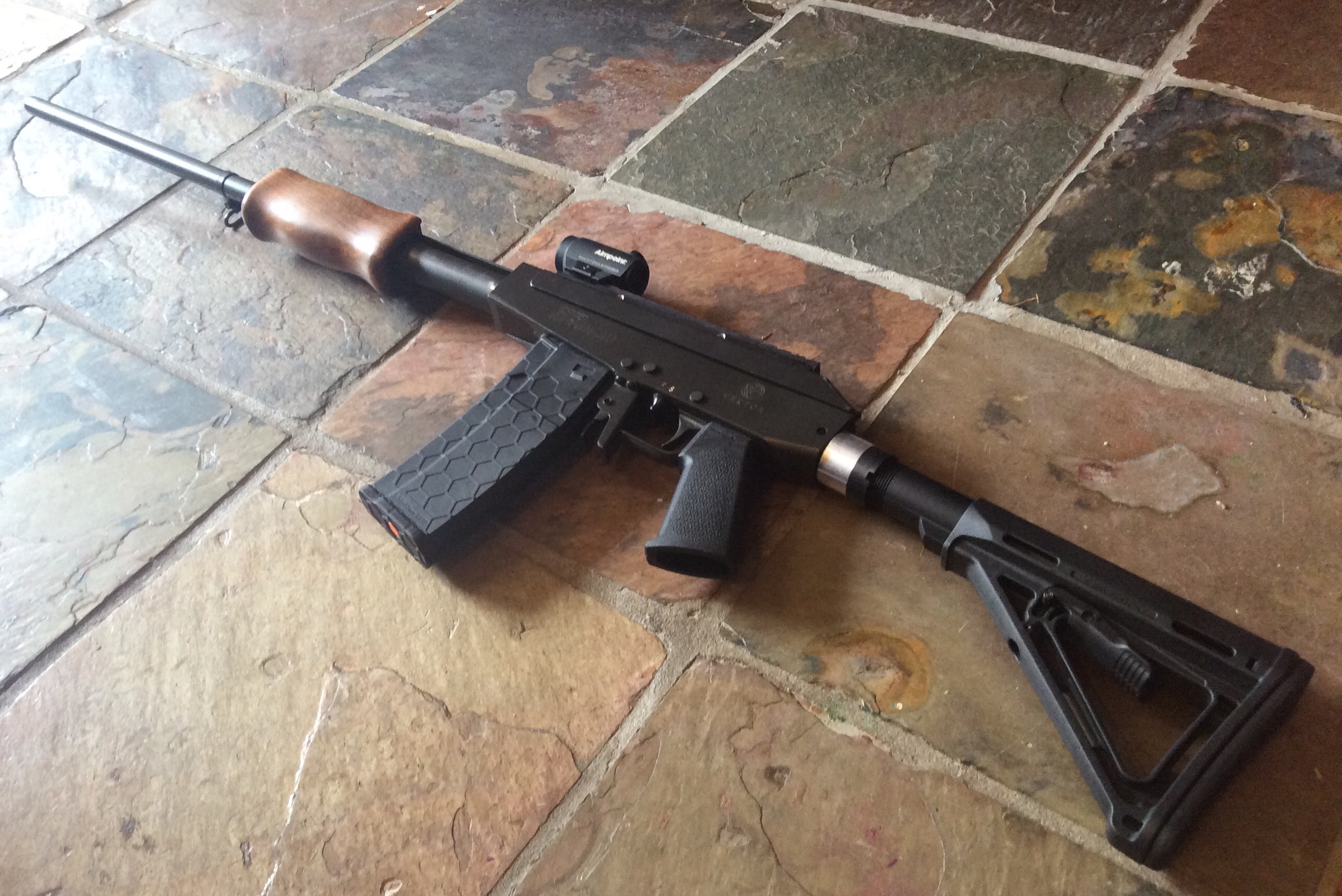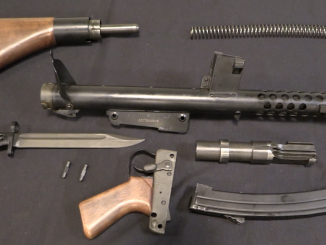The story of the Austen submachine gun did not end when the Mk I guns were pulled from combat service in 1944. The manufacturer continued to work on an improved version, which would be ready in 1946, after the end of World War Two. Only 200 were made total, and they were both adopted and declared obsolete in August of 1946.
The changes made to the MkII Austen mostly involved increasing the use of die cast components, which fit the manufacturer’s tooling and experience. The front grip and magazine well casting was enlarged, and the whole rear assembly was made into a second cast part integrating the rear sight, stock mounting and latch, and fire control group. The one significant internal change was to remove the firing pin from the telescoping recoil spring assembly and make it an integral feature of the bolt face.
Many thanks to the Royal Armouries for allowing me to film this very rare artifact! The NFC collection there – perhaps the best military small arms collection in Western Europe – is available by appointment to researchers. However, you can browse the various Armouries collections online.




Adopted and declared obsolete in the same year. Not many guns can make that claim.
I don’t remember when it was in the stores but, I seem to remember a TOY gun from around the late 1960’s or early 70’s that had the same profile as this gun. The same grips and receiver looks. Makes me wish I had placed one back on a closet shelf now.
If they weren’t so rare, I’d expect one to show up as a blaster in a Star Wars movie. The barrel retainer up front already has a distinctly science-fictional appearance.
cheers
eon
Allen, are you sure it wasn’t a Beretta model 12? I remember that toy from about then.I thought it was totally made up until I saw it in the 1964 film THIN RED LINE – being used by Japanese troops !
The stupidity of some movie-prop departments knows few bounds. The availability of period-correct Type 100’s for that era was near unattainable and yet “bad guys” always need advantages in fire power in the film! So long as the audience doesn’t get a closer look, the deception is sound.
Check out DUCK YOU SUCKER for Rod Steiger as a WWI era Mexican Bandit turned revolutionary walking fire with a butless MG42. TV programs of my youth- every German pistol was a LUGAR even when the guys holding a P38 & every Japanese pistol a NAMBU no matter what it was.
“Powderkeg”, the pilot for the short-lived 1971 Bearcats! TV series starring Rod Taylor and Dennis Cole, was supposedly set in the American Southwest in 1914. But there was a sheriff’s deputy wearing a WW2 U.S. M3 “shoulder” (actually more of a “chest”) holster for a 1911. and he had a Walther P.38 in it.
Oh yes, they also used Lewis LMGs and BARs. And Curtiss JN-4D “Jennies”.
About the only things they got right were the 1914 Stutz Bearcat replicas they used;
https://www.imcdb.org/v011847.html
If they’d said the series was set just after WW1, around 1920-24, which is what it looked like anyway, they wouldn’t have had a problem.
Other than that, it was a decent action/adventure TV show.
When I watch it on DVD, whenever someone mentions the year, I mentally blue-pencil it and write in “1920”.
cheers
eon
“(…)stupidity of some movie-prop departments knows few bounds(…)”
I would say that generally in 1960s movies, such details were given not so much care as today. Take for example: https://en.wikipedia.org/wiki/Battle_of_the_Bulge_(1965_film)
it is understandable that they did not have working Tiger, so used other tanks instead. But how many spectators would learn from that depicted event take place in snowy and cold European winter of 1944/1945?
They could have used German Haenel-Schmeisser MP28s or Bergmann MP20s, instead. Both were easily obtainable in Western Europe back then, and the IJA did in fact actually use the Bergmann during the war, notably in China.
An MP28/II did show up in Indiana Jones and the Last Crusade, along with Bergmann MP35s. The MP28 suffered a classic malfunction for its type;
http://www.imfdb.org/wiki/Indiana_Jones_and_the_Last_Crusade#Haenel-Schmeisser_MP28.2FII
cheers
eon
Check out the 1958 Victor Mature movie TANK FORCE. The Afrika Korp is wielding SMBs with SNAIL DRUM MAGAZINES.
Actually, part of ugly camouflage, the gun is nicely packaged for assembly and disassembly. Simple, logical, no tools. Wish to see it firing.
Fat chance we’re going to see Ian shoot it, but I don’t disagree that we will learn about its qualities in ballistic performance and handling faster that way.
Very good presentation as usual Ian. One can see these guns in museums in Australia, but are not as common as the Mk1 of course. There is another Australian SMG which you may be aware of, the MCEM-1 (means Machine Carbine Experimental Model, also known as the ‘Kokoda’) which was developed around the end of WW2. There may have been a second version of it as well. It is an interesting design, with the magazine in the pistol grip, but was a miserable failure. There are photos of it on the web and in Wardman’s book.
“(…)photos(…)”
https://augfc.tumblr.com/post/86801805945/kokoda-mcem-1-origin-australia-date-1943